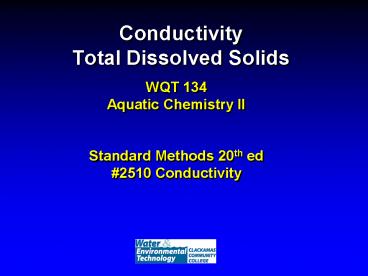Conductivity Total Dissolved Solids - PowerPoint PPT Presentation
1 / 17
Title:
Conductivity Total Dissolved Solids
Description:
Conductivity Total Dissolved Solids WQT 134 Aquatic Chemistry II Standard Methods 20th ed #2510 Conductivity Week Objectives 1. Understand the role and function of ... – PowerPoint PPT presentation
Number of Views:1329
Avg rating:3.0/5.0
Title: Conductivity Total Dissolved Solids
1
ConductivityTotal Dissolved Solids
- WQT 134
- Aquatic Chemistry II
- Standard Methods 20th ed
- 2510 Conductivity
2
Week Objectives
Reading assignment American Public Health
Association (APHA), American Water Works
Association (AWWA) Water Environment Federation
(WEF). 1999. Standard Methods for the
Examination of Water and Wastewater, 20th
edition
- 1. Understand the role and function of
conductivity in water treatment. - 2. Understand how to measure conductivity (SM
2510) - Relate conductivity to total dissolved solids
3
The conductivity of the source water indicates
the quantity of dissolved material present.
- True
- False
4
Conductivity 2510
- What is conductivity?
- This test is designed to determine if the sample
can carry an electrical current via the movement
of ions. This ability depends on the presence of
ions on their total concentration, mobility, and
valence and on the temperature of measurement.
Conductivity is an indication of the quantity of
ions contained in a solution - Why do we care?
- Dissolved ions/substances/electrolytes in water
- Determine the presence of salt water intrusion
- Used for WQ in pipelines, channels, flowing
streams, and lakes
5
Conductivity 2510
- What are the units and conversions?
- Conductivity is customarily reported in micromhos
per centimeter (µmho/cm). The electrical
measurement of conductivity is the inverse
(reciprocal) of ohms (1/ohms) or mhos. - In the International System of Units (SI) the
reciprocal of the ohm is the siemens (S) and
conductivity is reported as millisiemens per
meter (mS/m) - 1/ohm 1 mho 1 Siemen
- 1000 micromhos/cm 1000microSiemens/cm(µS/cm)
6
Conductivity 2510
- What are disadvantages of the procedure?
- Conductivities greater than 10,000 to 50,000
µmho/cm or less than about 10 µmho/cm may be
difficult to measure with usual measurement
electronics and cell capacitance.
7
Conductivity 2510
- What are typical values in nature?
-
Range - Pure Water 0.05 µS/cm
- Demineralized Water 0.1 to 1.0 µS/cm
- Distilled water 1 to 10
µS/cm - Tap Water 100 to
1000 µS/cm - Potable water 50 to 1500
µmhos/cm. - Industrial wastes 1000 to
10,000 µS/cm - Seawater 30,000
to 50,000 µS/cm - 5 Sodium Chloride Solution 70,000 µS/cm
- 10 Sulfuric Acid Solution 140,000µS/cm
8
Conductivity and Total Dissolved Solids 2510
TDS (Total Dissolved Solids) is the amount of
solids dissolved in a water sample. SS
(Suspended Solids) is the amount of solids that
have not dissolved into a water sample, or solids
that are insoluble in water. TS (Total Solids)
TDS SS.
9
What does TDS stand for?
- Total dissolved solids
- Temporarily dissolved solids
- Total disaggregated solids
- Total dissolved salts
10
Total solids can be divided into suspended solids
and ________ solids.
- Colloidal
- Dissolved
- Settleable
- Filterable
11
The total solids in water would be a combination
of
- Fixed solids and settleable solids
- Dissolved solids and volatile solids
- Dissolved solids and suspended solids
- Suspended solids and fixed solids
- Fixed solids and dissolved solids
12
Conductivity and Total Dissolved Solids 2510
- Estimate total dissolved solids (mg/L) in a
sample by multiplying conductivity (in micromhos
per centimeter) by an empirical factor
(Conversion done on Hach Probe). - This factor may vary from 0.55 to 0.9, depending
on the soluble components of the water and on the
temperature of measurement. - Linear in dilute systems
13
Suspended solids, also referred to as filterable
residue, represent the weight of solids remaining
on a glass fiber filter following filtration and
drying at ___ degrees C.
- 35.0
- 44.5
- 180
- 103
14
___________ solids remain in liquid solution and
are defined as the solids that will pass through
a 0.45um membrane filter.
- Suspended
- Colloidal
- Dissolved
- Settleable
15
__________ solids, extremely fine particles, will
not settle from the liquid portion, but can
usually be filtered from the liquid with a
0.45-um membrane filter.
- Dissolved
- Colloidal
- Suspended
- Settleable
16
If the residue remaining on a filter paper is the
suspended solids, these are the solids that pass
through the filter.
- Dissolved (TDS)
- Volatile
- Non-volatile
- Settleable
17
Conductivity 2510
- Summary?
- Conductivity not impacted by pH
- Conductivity impacted by dissolved
solids/sulfate - Conductivity/Resistance increases with
increasing - temperature.































